#painted world of ariandel
Explore tagged Tumblr posts
Text

sister friede studies from last month :)
688 notes
·
View notes
Text

+ℭ𝔬𝔪𝔪𝔦𝔰𝔰𝔦𝔬𝔫+
792 notes
·
View notes
Text
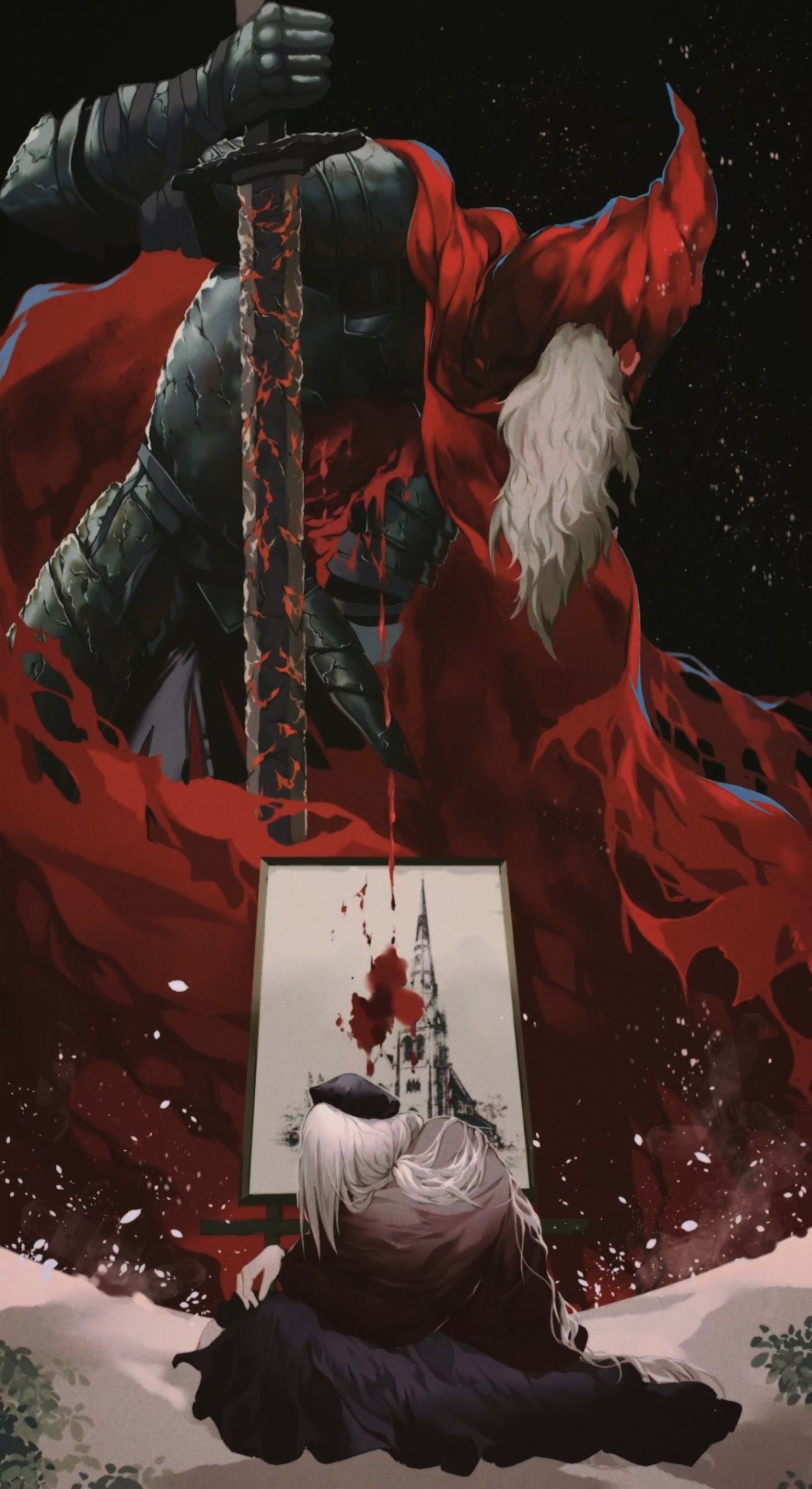
I wonder when Uncle Gael would return?
I hope the new painting will bring him closure…a cold, dark, and very gentle place of our home.
#dark souls#dark souls 3#soulsborne#slave knight gael#painted world of Ariandel#fan art#art#elden ring#bloodborne
2K notes
·
View notes
Photo

Sister Friede - AnatoFinnstark
#Sister Friede#AnatoFinnstark#Dark Souls#fighters#magic#winter#Painted World of Ariandel#dark fantasy#digital art
67 notes
·
View notes
Text

This is so funny when your name is actually Ash
7 notes
·
View notes
Text

Wolf got stuck
#dark souls iii#ds3#dark souls 3#wolf#wolves#animated gifs#animated gif#games#gaming#video games#videogames#game glitches#npc#painted world of ariandel#fromsoftware#soulslikes#souls
5 notes
·
View notes
Text

Sif grave???
#i hated the gravetender fight#wolves are my enemies#painted world of ariandel#dark souls 3#ds3#ashen one#ezekiel
2 notes
·
View notes
Text


#mood#dark souls 3#painted world of ariandel#dark souls dlc#videogames#videogames quotes#dark souls quotes#dark souls
3 notes
·
View notes
Text

an old old piece i did for a class that i'm still quite proud of
Ariandel Chapel, digital, 2022
27 notes
·
View notes
Text
I painted the Painted World of Ariandel from Dark Souls 3!

Original and prints available: https://www.etsy.com/uk/shop/SarahVittle
35 notes
·
View notes
Text
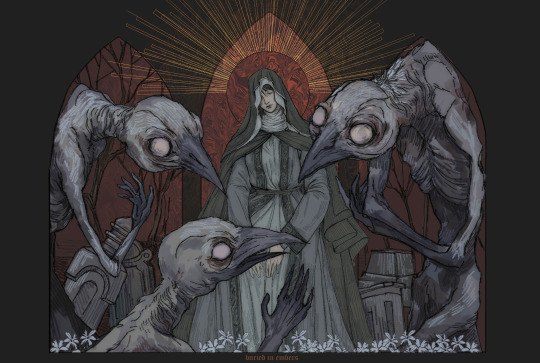
our lady of sweet decay
#dark souls#dark souls 3#sister friede#friede#corvian#ashes of ariandel#firstly it was a drawing dedicated to the painted world and corvians#but for the reasons unknown sister friede just SPAWNED into the art#as she has done for plenty of times before that???#she haunts me and make me draw her again and again i tell you#buriedinembers
3K notes
·
View notes
Text
The Soul Still Burns: Analysis of the Lords of Cinder (DS3)
What follows is a short essay on the Lords of Cinder from Dark Souls 3, exploring their symbolism on spiritual and metatextual levels. After that is a related reading of Slave Knight Gael, the final adversary of the Dark Souls trilogy.

The Lords of Cinder are in many ways the primary adversaries of Dark Souls 3. This title they share, “Lord of Cinder,” refers to a personage who has rekindled the first flame, keeping the cycle of light and dark going.
Cinder is a substance which continues to burn without the presence of fire but does not reduce to ash. So euphemistically, it seems that the Lords are somehow stuck in their process of purification, and the game suggests that the world is stuck along with them; this is why it is the Ashen One’s task to “set them upon their thrones”—to hurry them along and thus allow the world to follow its natural decline. As individual characters, each of these Lords represents a different attitude that complicates and prolongs the cycle.
Through these stubborn Lords the game is commenting on at least two things. On the metaphysical level, it reflects the Buddhist idea that certain attitudes keep people reincarnating over and over again, unable to extricate themselves from the material world of suffering (samsara). While on the metatextual level, the game is suggesting that certain attitudes keep players coming back to Dark Souls again and again, starting new games, making new builds and revisiting old files.
The idea there on the metaphysical side finds an easy analogy in Buddhist doctrine: the “three poisons,” the three root causes of suffering. These are hatred, greed, and delusion. What’s interesting is that these essential vices also fit pretty easily onto the different types of players that are being caricatured by the Lords. We’ll break these correspondences down in a second.
But First: Why Do They Correspond? So we have these sets of three. Three lords, three poisons in Buddhism, three types of Souls players. How convenient. When we analyze art, we sometimes ask, “Huh, is this structure really there, or am I projecting it into the material?” And if the structure is really there, baked into the work, that doesn’t mean that it’s due to developer intention. Archetypal forms sometimes show up in work via an unconscious influence, be it due to the cultural milieu, personal psychology, or some a priori biological disposition of the human being.
And the thing about Dark Souls is that it’s an unusually honest piece of art, in that its creative team allows their own free associations and intuitions to show up in the work without too much self-censorship or questioning. They make space for a mystery to show up on its own terms, and in leaving its riddles unanswered, there is more space for discovery by the people who play it.
It should also be said that cultural ideas persist for a reason. Beneath the ethics and ideology of the people who originally named the Buddhist “three poisons,” there may be something timeless, something perennially descriptive of human nature. If that is the case, then it would make sense for this same triplicity to unfurl itself in other cultural products. So for one reason or another, these three poisons, these addictions, show up diegetically in the characters and are also expressed in player psychology.
I say all this just because sometimes I feel very aware of the disconnect between much of Souls lore discourse and the broader field of mythological study. Since we are gamers first, there may be this tendency to want to “solve” the lore, but that’s not what we’re doing here. Myth functions because it elaborates our experience of the world through affective resonance; it attaches images and characters and stories which help us anchor our own prelinguistic impressions of the world, cultivating our sensitivity there.
Anyway, let’s look at these Lords.

Abyss Watchers Poison: Hatred The lore of the Abyss Watchers is pretty clear: they have an obsessive fixation on the abyss, and are ready to raze an entire town if they suspect abyssal encroachment. This obsession has literally possessed them, as they are now “abyss touched.” Gaze too much into the abyss, etc. They carry such strong contempt for the disavowed object that they don’t care what comes between it and their sword. This is clearly demonstrated by the fact that they are a brotherhood yet are unhesitatingly slaughtering themselves again and again. Hatred has made them blind, and has also caused them to resign their individuality (they are identical, mere instruments of a transpersonal grudge). They cannot die, their hatred keeps them locked in combat.
Type of Player: competitive | Interest: combat The Abyss Watchers are a representation of PvP addicts. They have no powers other than tenacity; they perform the same combos repeatedly. When you are really gripped by a PvP binge in Souls, you often end up doing the same thing again and again. The fight takes place in a mausoleum, on top of many chambers filled with human remains. The fact that this boss fight is instructional about combat, specifically about looking for tells (a cloud of dust always signifies the end of their combos) might be another clue. There is no limit to how good you get at Souls PvP; every foe is an opportunity to improve timing and strategy. You can just keep stacking anonymous bodies under yourself.
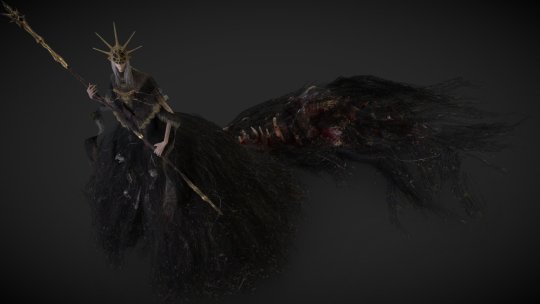
Aldrich Poison: Greed Aldrich invokes the concept of supremacy many times: he is in the supreme area from Dark Souls 1; in the supreme boss room of that area; he wears as a crown the former supreme lord of that area. This is because he devours lords; he tries to take prestige upon himself through acquisition and incorporation—greed.
Type of Player: completionist | Interest: content Aldrich is a commentary on completionist players. He is someone who “plays the game to death”, acquiring every object, reaching every achievement, devouring the soul of the game through taking everything into himself. He becomes bloated by consuming as much of the game’s content as possible. The old God whose likeness he has adopted is Gwyndolin, who was, in narrative terms, the one pulling the strings in the land of the Gods. And in gameplay terms, he is a secret boss. So on both counts we have someone who is elusive, and exists more or less at the boundary of the gameworld. When a player tries to see every last little morsel of a game, they become somewhat like Gwyndolin, a manipulator of a virtual world. If you know too much about a game, you have the risk of being less immmersed.
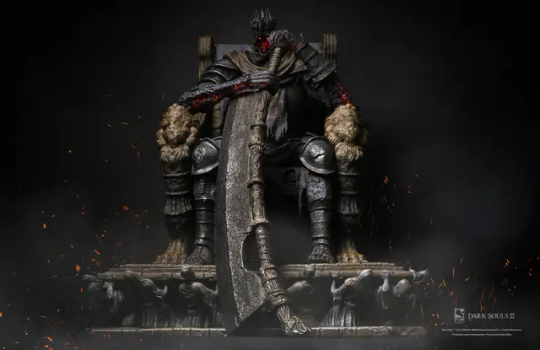
Yhorm Posion: Delusion In Buddhism, the poison of delusion secretly underlies the other two poisons, as the impulse toward hatred and greed are ultimately born of some false view about reality. This is akin to how the profaned capital sits below the rest of the kingdoms. To beat Yhorm you essentially have to “play pretend” with him, picking up a fake super-weapon, or fighting alongside Siegward, a knight who appears to be somewhat deluded about the state of the world, enthralled in the same fantasy as Yhorm himself.
Type of Player: lore researcher | Interest: meaning The profaned capital is full of statues—fixed images of myth; and empty goblets—treasures with no utility. Not to mention the area with the swamp which is full of symbolic imagery, but serves no narrative or mechanical purpose. The entire profaned capital challenges us to make sense of it; it is the ultimate temptation of lorekeepers in DS3. It throws at us a disproportionate amount of reference to DS2, which is famous among Souls players as the least thematically sensible Souls game. The Greatshield of Glory is found right outside Yhorm’s room, in a conspicuous room full of treasure, and yet it is a very impractical shield and offers very little lore value. If a lore-minded player picks it up, it directs them to a legendary personage from the War of Giants, which raises far more questions than it answers. The same is true of much of this area—the Eleanora, the Monstrosities, the Profaned Flame itself—they are all there to get you to speculate. These are the players who come to Souls games again and again, trying to find the “ultimate meaning.” They seek the grail, claim to find it, and then chuck in a pile with the others.
Yhorm's story also imitates the primordial Artorias myth: forsaking his shield in preservation of something more valuable. Other than that Yhorm is largely a cipher when it comes to biography, with a void for a face, which itself epitomizes what must remain at the center of mythology and storytelling: mystery.
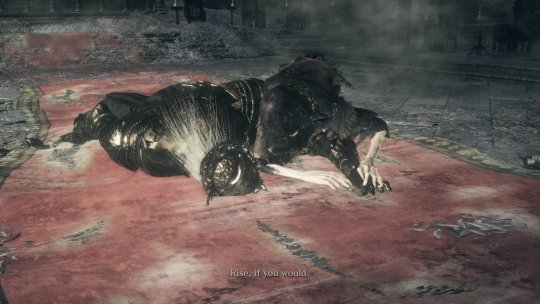
Sit Down and Seek Guidance So we have the three reasons that people become fixated on Souls: the combat, the achievements, and the mystery. But there is a fourth lord of cinder boss, who is conceptually apart from these three: the Lothric Twins. They represent yet another kind of person who must keep playing Dark Souls: the developers. Lothric is striving to produce “a worthy heir,” a proper sequel to Dark Souls 1. The Princes are bound to their chamber as the developers are bound to their project, as that is their curse—“but you may rest here too, if you like.” In this context we can see their duality as the dual nature of having to work on the game and also play it to death. The privilege and the loftiness of the promise of a great piece of art (Lothric), and also having to go back "into the trenches" of the work itself (Lorian). Notably, neither of them can walk, they just teleport around. They are stuck at work, trying to bring the new world into being. Also I can’t go this whole essay without mentioning the obvious: that the Ashen One is bringing Lords to their thrones, and we players and developers have to assume our little chairs and couches when we access this world.
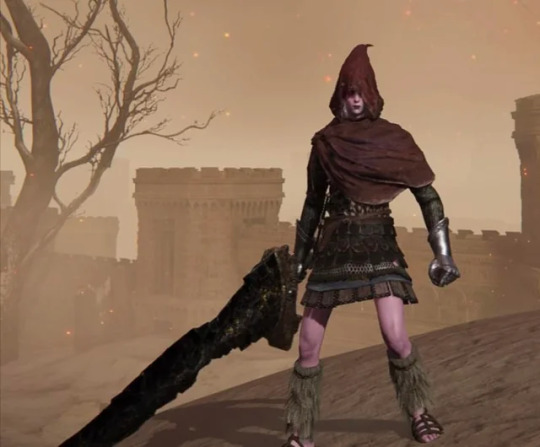
Playing Beyond the Point of Pleasure Of course the most extreme example of someone stubbornly remaining in the world no matter what is Slave Knight Gael. He is looking for pigment, which seems to be a euphemism for the substance of humanity (the Dark Soul). He wants to give it to the painter, the world-creator, so that a new world can be made. He is willing to indulge in a wasteland of abject violence for as long as it takes in order to renew something. Ironic that he is probably only prolonging the current world in his obsessive drive to recycle it faster.
Let’s examine the relationship between the figure of the painter and her relationship to Gael. That she is a spiritual entity is obvious: we never see her touch the ground, she is always in an upper room and lifted on a piece of furniture. Among other things, she is a clear metaphor for life springing eternally. A creative child who continues to paint despite kidnapping and imprisonment. She is the heart of the painted world, itself a place that symbolizes the idea of the representation of reality.
I want to make sure this is clear, because it is a bit of a kaleidoscope to consider. Any subject in Dark Souls stands for many things, but something that the painted world specifically represents is the very concept of representation. So of course the places in our imaginations are painted worlds, but so is this physical world of appearance, the maya of mundane reality. Not to mention that a work of art is a painted world, and the game we’re discussing is a painted world. When a work of art is able to recreate itself in itself, we can see this funny effect of mirrors reflecting mirrors infinitely. This results in seemingly inexhaustible symbolic content—there is so much potential to find meaning and create connections. Because Moby Dick represents a work of literature; the Tempest represents a play; Twin Peaks represents a TV show, these works can offer extensive insights not only into their medium but into the nature of reality. In these and other examples, the representation of the medium within the work may or may not be a single subject, but since Dark Souls is formally a game about levels and level design, the painted world is the heart of its self-reflexivity. The painted world can be pointed to as the summary of this fractal device. And the personification of that device, its ambassador to the player, is the painter.
The miracle or divine child is also an archetype familiar to us from Lothric, in their struggle to produce the “worthy heir.” Reality seeks salvation through the appearance of grace. They want it in a clear, incontestable form—to be able to point at it and say, "thank goodness we went through all that, because look, now here is the meaning, here is that which validates all that came before." In the world of Dark Souls 3 the religion of the masses is the Lothric stuff; meanwhile knowledge of the painted world is much more obscure. Lothric’s religion is obviously regulated and hierarchical, while Gael’s devotion to the painter is highly personal and private: he carries around a scrap of painting; he prostrates to a hidden idol in a small chapel; he considers the painter his family. He is emotionally close to the object of his worship.

But whether it’s Lothric or Ariandel, they are anticipating the divine child to redeem the world. As an archetype, the child ultimately represents surprise. The possibility of being delighted by life in its creative novelty. The child as an archetype appears in our own behavior when we do something without any sort of contrivance or mental interference, doing something in the world which doesn’t seem to have come from who we conceive ourselves to be. This is miraculous. Such an action enchants the world, and there is no explaining it, even if it may weave all kinds of stories around itself, retroactively framing things that have led up to it as portents or promises. (Though not exclusive to him, this trait is well-known in characterizations of Christ, and DS3 is clearly indebted to Christian iconography, so do with that what you will). Regardless of the specific cultural invocation, the divine child is a personification of something that happens within the human spirit. TFW you are renewed by a fresh and spontaneous engagement with life.
The grace of the miraculous often comes to us through play. Play is more of an attitude than an activity; the feeling of play may come to us through making a painting, or chatting with a friend, or moving around in a video game. We can play video games idly, competitively, experimentally, creatively, studiously, whatever, the feeling of “play” can show up regardless. We can sit there playing a certain game from a certain motivation, and feel totally rote and joyless, and question, “Why am I doing this?” Or we might sit there and play the same game with the same motivation, feeling totally lit up by it, its purpose to us obvious and self-validating. We are not even questioning why we are doing it, we are enjoying life.
This is really the ground that the miraculous tends to land on. Grace, meaning, and an immanent love of life are more likely to show up when we are in flow and not exercising our capacity for self-assessment. But like everything in life, we mistake the images and objects around us for the feeling of grace. Any given object might only be the catalyst once; it’s not about the object. This is extremely easy to see in cases of acute nostalgia; adults chase enchantment through collecting Zelda memorabilia or going to Disneyland, in pursuit of what kindled their spirit as a child. It was never really the game or the character that was doing it, it was what they were able to access within themselves.

So anyway Gael has yet to realize this. He thinks the Dark Soul is out there in something else. That it will be yielded as a drop if he just kills the right enemy, or 10,000 enemies, or goes to the right place at the right time. You can see that this is something of a synthesis of all the other Buddhist defilements: there are elements of completionism/greed, violence/hatred, mysticism/delusion. There is even the suggestion of the developer of these games again, in that Gael is a “slave,” forced into participation in the world to assist some creative apotheosis. (Isn’t it funny that his weapon is a worn-down executioner’s sword?—whether the person coding or the person playing, we are all “executing” command after command). The thing that really keeps him on the wheel is something beyond any of the player types and their vices; it is almost some sort of pure, amoral automatism, a churning drive that on one side resembles wanton nihilism, and on another side single-minded piousness. Is one disguised as the other, or has Gael somehow stepped beyond this binary? Yet another dichotomy in Dark Souls that begs to be reconciled, but whose tension creates the opportunity to participate creatively in its expansive mythology. When things are held apart we can move between them.
To really understand Gael, we have to contend with the question of a person’s relationship to their own soul, since that relationship is so plainly suggested by Gael and the painter. (This question, by the way, is much elaborated in Elden Ring, with its repeated foregrounding of the image of the maiden or “consort”). If we were to see Gael and the painter as partitions within one person--whether she is his soul, or his inner life, or his better nature, whatever—then in any case Gael is the side which goes out into the world and experiences it. He is the creative extension into the world as its active participant and realizer. Yet he is clothed as the warrior, the executioner. While the one who is dressed as the artist, the painter, just stays in her room and imagines the world—but this is where the magic of creation is really felt. We involve ourselves in life, or in a game, but we are only really changed and renewed when that exterior experience is “brought home” into the inner life. We do something “in the game,” but the act of “painting,” in renewing the world through our creative interpretation, is a decidedly interior experience.
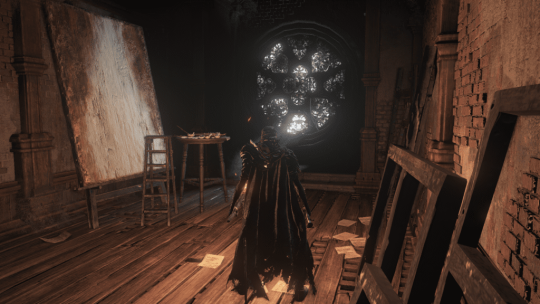
#dark souls#dark souls 3#lords of cinder#game entrainment#dark souls analysis#dark souls lore#ariandel#slave knight gael#the painted world
90 notes
·
View notes
Text
Also have read earlier a theory about friede being the painter girl's mother and while definitively i think she was priscilla's daughter i am like damn. Kinda in love with the idea of friede gaslighting the painter girl into believing she really is her mother because priscilla died when she was so young she can only remember the most basic things about her like the schythes and the long dress
#the painted world has the opportunity to become the worst family sitcom ever#again it would work for my friede characterization as in she has already raised yuria and liliane being much older than them#and also i see her as someone who craves connection (and being actually successful at making it!) no matter the means#so like pretending to be the girl's mother + keeping her in check so that she doesn't create a new painting Would work#the post also mentioned that there are several paintings of friede around the church which means they must have had frequent contact#which cool because i somehow never made the connection#(i also do not really see friede as wholly. malicious yk. a deeply deeply selfish woman but like#not the one to mistreat or abuse ariandel/the girl/vilhelm like i have seen sometimes)
2 notes
·
View notes
Text




I've been spending a lot of time researching places I can feasibly move to. I'd quite like to get out of the (barely) United States. Unfortunately, I don't think the Painted World of Ariandel will make the cut.
The search continues...
244 notes
·
View notes
Note
Can you please do a romantic concept *or* alphabet for Sister Friede (Dark Souls 3)?
🕊️ anon
Always found Alphabets easier for Souls characters... So I hope you enjoy.
Yandere Alphabet - Sister Friede
Pairing: Romantic
Possible Trigger Warnings: Gender-Neutral Darling, Obsession, Overprotective behavior, Isolation, Controlling behavior, Smothering behavior, Manipulation, Murder implied, Forced relationship.

Affection: How do they show their love and affection? How intense would it get?
Imagine if you are a forlorn who resides in the Painted World of Ariandel. You would be under the protection of Sister Friede. This is your new home, just as it is for her...
Except it appears she likes you more than you thought.
Sister Friede, in her obsession, claims she hasn't truly loved someone until she met you. The feelings you create within her are new. As a leader in this world... She has chosen you as her partner, like it or not.
Sister Friede gives off the illusion of being gentle. She's quite trusted among the inhabitants of the painting. However... She can be quite manipulative.
Her affection, if you behave and listen to her words, is soft and comforting. She touches you gently and presses soft kisses to your skin. Her adoration appears curious yet also soft.
Yet when angered, her touch carries a hint of a threat. As though if you make one wrong move... you could easily be cut. But she'd never hurt you....
In terms of her intensity, she is mostly tame, until her beloved tries to leave this painted world...
Then she becomes desperate.
Blood: How messy are they willing to get when it comes to their darling?
Sister Friede values her new home to the point of trapping a painter to prevent this one from ending... and slaughtering the Ashen One over and over again to prevent flame from occurring.
I'd say, if she feels it's needed, she would use the scythe she wields to slaughter anyone who not only threatens her home... but the one she claims to love within it.
You will never see flame... She will be the only warmth you feel in this freezing painting.
Cruelty: How would they treat their darling once abducted? Would they mock them?
You will be treated well and protected with her life. She would never mock you. You are one of the only companions she has left...
Or at least the only one she's completely infatuated with.
Darling: Aside from abduction, would they do anything against their darling’s will?
Aside from trap you in the painting? She'd probably suggest keeping you in the cathedral. After all, it's cold outside, isn't it?
You could argue her affection towards you is against your will, too. Yet she tries to give you freedom as much as she can.
As long as you come back to her arms.
Exposed: How much of their heart do they bare to their darling? How vulnerable are they when it comes to their darling?
While she mostly seems cold like the painting she calls home, she would care about the one she loves. She may not be the most vulnerable person, but she does show care.
As the one she loves in this freezing landscape... She is yours to love and she'll care for you no matter how she shows it.
Fight: How would they feel if their darling fought back?
Disappointed yet is quick to push such thoughts from your mind. Why do you fight? Are you scared of the rot here? You shouldn't be...
Isn't being without a home... without her... worse than that?
Game: Is this a game to them? How much would they enjoy watching their darling try to escape?
No and she would feel offended and betrayed that you'd try to escape.
Hell: What would be their darling’s worst experience with them?
The Isolation of the painting is bad enough... but the moment she locks you in the cathedral to protect you from the cold and rot might be it. Others have done worse, sure... and it doesn't sound bad.
Yet it reinforces the fact that escape from her is useless...
The only escape is fire... she'll never let her love see a flame.
Ideals: What kind of future do they have in mind for/with their darling?
It's most likely to keep you in the painting forever, to make you her lover and for you both to accept the rot of this world together.
You'll live with her...
You'll die with her.
Jealousy: Do they get jealous? Do they lash out or find a way to cope?
Who is there to be jealous of? She has no need to worry about such a silly thing. You'll always be hers. If you aren't...
Her scythe may just taste blood once again.
Kisses: How do they act around or with their darling?
Isolating and overprotective. She's smothering in her care, treating you like you're something precious. In reality, while you came here looking for a home, this painting is now your rotting prison.
Love letters: How would they go about courting or approaching their darling?
As said near the beginning bit, you came here feeling you had nowhere else to go. Upon entering the painting, you meet Sister Friede in the cathedral. She's welcoming, despite her cold exterior.
Over time, she'd gain your trust and guide you through your new home. While you see her as a guide, a guardian of this world...
She sees you as her one and only love...
Whom she'll never allow to leave this painting, and by extension her, ever again.
Mask: Are their true colors drastically different from the way they act around everyone else?
She's more affectionate with you... with lingering touches and words of comfort. Other than that, she's mostly cold to anyone else.
Naughty: How would they punish their darling?
Isolation, I assume. Although if you made countless escape attempts... She may have to restrain you.
Her scythe is not reserved for you...
It's for any who threaten her home... or her love.
Oppression: How many rights would they take away from their darling?
Considering your situation... I imagine many in exchange for a home... and her love.
Patience: How patient are they with their darling?
Very patient. She's learned it in her time staying here. Hopefully you will too.
Quit: If their darling dies, leaves, or successfully escapes, would they ever be able to move on?
She probably wouldn't for a very long time... If at all, honestly. When you're not here...
The cold really does begin to set in...
She'd do anything to bring you back... yet it's probably futile unless you're Unkindled.
Regret: Would they ever feel guilty about abducting their darling? Would they ever let their darling go?
No and most likely not. This painting is your home now. Where you'll be right beside her.
Stigma: What brought about this side of them (childhood, curiosity, etc)?
I assume isolation. Yet I feel it's hard to tell.
Tears: How do they feel about seeing their darling scream, cry, and/or isolate themselves?
She'd allow you to have some distance... but once your tantrum ends, she scoops you into her arms and kisses your forehead.
Why must you fight the one protecting you?
Unique: Would they do anything different from the classic yandere?
SKIPPED
Vice: What weakness can their darling exploit in order to escape?
You alone? Nothing much. If you're the Ashen One or meet the Ashen One?
There's always lighting a fire within this freezing world so it can burn away....
Wit’s end: Would they ever hurt their darling?
Not intentionally.
Xoanon: How much would they revere or worship their darling? To what length would they go to win their darling over?
She isn't quite a worship yandere. Although, sometimes she worships you for finding her and blessing her with love. Other times she may like to feel worshiped herself.
She'd obviously go to extreme lengths for you... like locking you away similarly to Father Ariandel and the flickering flame.
Yearn: How long do they pine after their darling before they snap?
She does not pine.
Zenith: Would they ever break their darling?
Unintentionally.
39 notes
·
View notes
Text
what are yall's favorites dynamics in all three Dark Souls games? for me:
Dark Souls 1: Gwyn and Velka


ohhh my beloveds, their story is very tragic i physically can't.
i think they were pretty healthy, they were a cute couple with Lloyd judging them in the back. they had three children (NK, Gwynevere and Filianore) and everything is good and silly... until humanity comes in.
while Velka was very friendly with the humans and affiliated more with the Dark even tho she's a goddess, Gwyn was scared and very paranoid of them and their power, and all the shits happens which led Velka to rebel against the gods, and Gwyn.
and so they cut off every connection they had, and Velka started her plan to kill the gods (the fact that Gwyn committed the "First Sin" and Velka being the goddess of sin starting the prophecy so that the undeads could kill Gwyn is just ejrkgowmrkglel)
they're very sad, and they are also so dear to me🙏
Dark Souls 2: Aldia and Navlaan/Royal Sorcerer


i've already talked about them in a previous post, they are so underrated it's crazy.
Vendrick and Aldia went to Majula to kill this clan of sorcerers, but Aldia decided to take one sorcerer (who was alive for some reasons) with him, that sorcerer was Navlaan's vessel. (he got the title of "Royal Sorcerer" so that means Vendrick accepted him as a member of the court, even tho he didn't like sorcerers very much lol)
Aldia and the Sorcerer were probably very close, while Aldia was researching for a way of the curse, the sorcerer was just trying to find some new forms of hexes.
and then they got locked up, which well caused them insanity, just like everyone in there. but still they were probably the sanest people in the keep, and that probably made them closer.
at the end Navlaan possessed the Sorcerer which caused him to isolate himself even more to prevent hurting people, and Aldia couldn't nothing about it. (he probably felt so bad☹️)
i'm very normal about them.
Dark Souls 3: Friede and Ariandel

it was hard to choose honestly, but i'd go with them!
another story that ended horribly, Ariandel was a Corvian who had the task to burn the Painted World. Friede was a woman of Londor who lived in the Painted World and found comfort in it.
Friede did not liked the idea of burning the Painted World. and so she manipulate Ariandel into thinking that it was a futile act.
the fact that the first thing Ariandel says to us is to bring Friede to him so that she could gave him his flail to prevent the Flame from burning everything☹️
oh and don't get me started on Friede being a huge parallel to Gwyn. she did the same thing Gwyn, aka "the guy that Londor don't like", did. Gwyn prevented a new age to come while Friede prevented a new Painted World to be created is just kwofkkewfkw
#dark souls#dark souls 2#dark souls 3#fromsoftware#soulsborne#gwyn lord of cinder#velka#aldia scholar of the first sin#royal sorcerer navlaan#sister friede#father ariandel
23 notes
·
View notes